|
Day Twelve, March 5, 1997 Montserrat
We arrived at Montserrat very early in the morning (3 or
4 a.m.), we maintained motor sailing, because new piers footings were being
assembled and we did not want to risk running aground any of them. So we
sailed back and forth until dawn broke, when at that time we anchored in
a small harbor, where there were only a few other ships. The Captain once
again went ashore to clear customs, while we prepared breakfast and for
the day ahead of us.
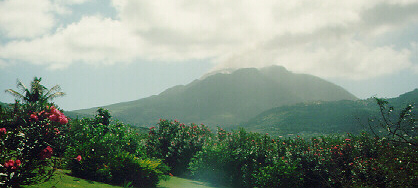 The view out the back of the Observatory
The view out the back of the Observatory
Once ashore we got two taxis for the day to tour the island.
Our first stop was to the Montserrat Volcano Observatory. The observatory
(which was a house) housed all the instrumentation and computers for monitoring
the activity of the volcano. We were given an excellent lecture on the
volcano's history and dangers, as well as the effect on the local population,
by one of the British geologists who runs the observatory. We were given
an overview of all the monitoring equipment within the observatory, the
room was completely air conditioned to maintain the safety of all the equipment.

Leaving the observatory, we began our tour of the island.
We viewed the growing dome from many different vantage points as we could
drive to. This year we could not climb up the volcano as it was now an
actively growing dome. Last yearâs field trip group was able to climb
up to view the caldera and look down upon the dome. One year ago, when
this trip first went they had to climb up the volcano to view the growing
dome. Now it is visible from neighbouring islands.
While we were touring around, we met up with another film
crew making a documentary for the American Discovery Channel. Apparently,
they were trying to assess 'How it feels' to view a volcano?. Sometimes
these type of journalists will go to great lengths to make useless footage
of items which are irrelevant to science. They interviewed some of our
group as budding geologists, on a field trip to Montserrat, with an in-depth
of look at its volcano. Most of our group who were interviewed answered
their questions quite well, (well as could be expected as some of their
questions were flaky, to say the least).
After that slight hiatus, we then proceeded to our last
stop of the day, where we hiked along the seashore to a hilltop below the
volcano, so we could view the results of a pyroclastic flow. From the hilltop,
we could see the path of destruction which leveled the mountainside of
all vegetation, and proceed right into the ocean. When the pyroclastic
flow hit the ocean, it spread out like an enormous alluvial fan. It was
quite a sight to see, and we were awestruck as we tried to comprehend the
magnitude of forces which had produced this feature.
We headed back out walking along the seashore. Some of
the girls played in the waves, others of us rushed back to the pick-up
site to nap for a while.
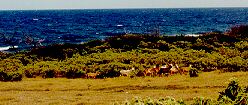 Baaaa, got the goats to look at the camera!! (5 points,
1 for every goat)
Baaaa, got the goats to look at the camera!! (5 points,
1 for every goat)
Before heading back to the ship, we stopped in Plymouth,
which was deserted due to an evacuation. Plymouth is designated within
the prime zone of danger which was eventually why the town was evacuated.
It was rained on by an ash cloud which devastated the entire city, not
only that but soon after the ash cloud, there was a flood which only increased
damage and devastation ten fold. Visiting Plymouth was like walking through
an old fashion western ghost town, it was a little eerie. Our driver, a
native of Plymouth was able to be a guide for us, he showed us buildings
which looked 20 years old, but had only built in the last year or two.
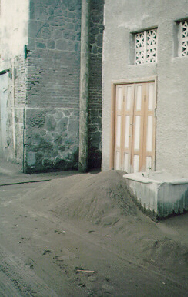 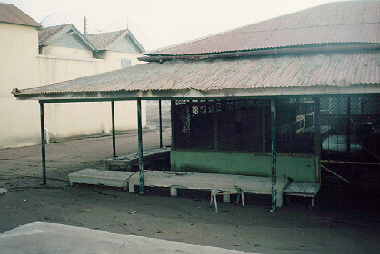
This was the market in Plymouth, the tables you see in
the back gound are supposed to be waist high, but as you can see, they
are now only about ankle high, as they have been buried by the ash.
Some of our group, which had been to Plymouth last year,
said it was a bustling little center of activity, which included a market
and lively town square. They were shocked by what was now, the prevalent
demeanor of the town.
It was a shocking wake up call to most of us, just to
see the effects which the volcano had delivered. It was all nice and grand
to come and visit, but people had actually lived there. We left with a
larger respect, to the danger which the people of Montserrat were threatened
with.
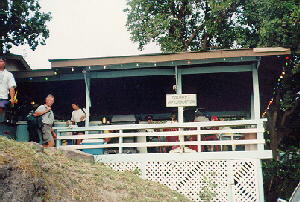 We
arrived at the pier to find that we had a little time before having to
be back aboard the ship. So we went into the restaront near the peir, and
had a drinks before heading back aboard. We ate, prepared for tomorrow's
day, and discussed what we would be doing. We
arrived at the pier to find that we had a little time before having to
be back aboard the ship. So we went into the restaront near the peir, and
had a drinks before heading back aboard. We ate, prepared for tomorrow's
day, and discussed what we would be doing.
We had anchor watch, as we were in harbor, most watches
took the time while on watch to develop a performance for the ships concert.
The shipâs concert would be tomorrow night before we would leave
for Antigua.
|
|